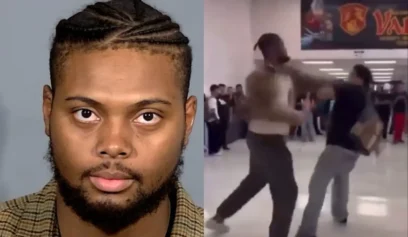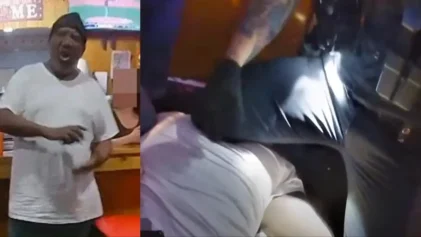A Wisconsin case from 10 years ago that’s eerily similar to Jordan Neely’s chokehold death demonstrates the similarity in treatment and the difference in law enforcement response.
It was December 2012. Corey Stingley was caught on surveillance video at the VJ’s Food Mart convenience store in a Milwaukee suburb placing alcohol bottles in his backpack.
The store clerk confronted the 16-year-old when he approached the cashier to purchase another item. The clerk emptied his backpack of the bottles of Smirnoff Ice he stuffed in his bag. Surveillance video shows Stingley snatching his debit card back from the register and trying to run off.

In that next moment, three male customers tackled Stingley to the ground and a struggle ensued. One held Stingley by his hair—another restrained Stingley’s back. The third had his arm wrapped around Stingley’s neck.
By the time police arrived at the scene, Stingley was lying on the floor unconscious foaming at the mouth and soaked in urine. Police assessed that the men had Stingley restrained for about six to 10 minutes before officers finally arrived. A responding officer handcuffed Stingley, but once the realization hit that he wasn’t breathing, an immediate call was placed for EMS.
The medical examiner ruled his manner of death a homicide due to asphyxia, physical restraint, and a violent struggle with multiple individuals. The names of the individuals involved, all of whom are white, were Mario Laumann, Jesse Cole, and Robert Beringer. Laumann, a former Marine, was the one who held the teen by the neck.
The total worth of that alcoholic beverage Stingley stuffed in his bag amounted to $12.
A recent ProPublica report not only revisited this incident but recounted the numerous attempts that Stingley’s father, Craig Stingley, made to get this case prosecuted over the last decade. He’s pressed Wisconsin prosecutors for years to investigate the incident and file charges with every effort coming up short.
Following the incident in 2012, all three men were arrested but later released. No criminal charges were filed. When investigators questioned all three, Cole told police he thought Stingley was “faking” his unconscious state when he stopped struggling.
“I didn’t know if he was just, you know, playing limp to try and get real strong and pull a quick one, you know,” Cole added.
Laumann told police that he was “just leaning on him,” which conflicts with witnesses who told police that a chokehold was used to subdue Stingley. Laumann died last year.
Police reports are filled with statements from witnesses who were at VJ’s that day in 2012. One person said they saw Stingley being restrained for up to eight minutes “by the patrons during which time he did not see the victim offering any resistance.” Another person told police he could see through the store’s glass door that a man with a “crazed look on his face” had someone in a chokehold and that the guy was “squeezing the hell out of this kid and never let up.”
Laumann was arrested again several days after the incident took place and charged with second-degree reckless injury. It all came down to Milwaukee County District Attorney John Chisholm who had to decide whether to prosecute Laumann and the other men. Chisholm put together a judicial proceeding to hear sworn testimony. All three men involved invoked their Fifth Amendment right and declined to answer questions.
It took more than a year for Chisholm to announce that he would not file charges, stating that the men did not intend to injure or kill Stingley and didn’t realize there was a risk to his life or health.
“It is clear that the purpose of restraining Corey Stingley was to hold him for police,” Chisholm wrote in a five-page summary of his investigation. “None of the actors were trained in the proper application of restraint.”
A second police review came about in 2017 which led to the appointment of a special prosecutor who took more than three years to post her decision at the behest of a judge. No charges, once again.
In 2022, Craig Stingley convinced a judge again to assign a third district attorney to reexamine the case. He alleged “dereliction and breach of legal duty” by the Milwaukee and Racine county district attorneys to conduct thorough criminal investigations into his son’s death.
Stingley and his wife did receive a settlement after filing a wrongful death lawsuit in 2015.
It took authorities in New York two weeks to criminally charge Daniel Penny with second-degree manslaughter after a massive outcry from citizens across New York City for prosecution. Stingley’s death took place on the day of the Sandy Hook school massacre and, as a result, did not receive the same amount of media attention.
However, the parallels between both cases are undeniable.

Both Jordan Neely and Corey Stingley were unarmed, Black males. Both didn’t become physically violent with the people around them. Both had been choked by former Marines and restrained by other bystanders. Yet, the reaction from those who wrestled them to the ground was that they both posed some sort of threat.
The only difference is in December 2012 we didn’t have the Black Lives Matter Movement. We were not yet polarized by the deaths of Sandra Bland, Philando Castile, and George Floyd. The nation did not yet experience the air of increasing public pressure to be better at criminalizing instances of police brutality and holding people accountable for actions that some, nowadays, would call heroic while others would deem excessive.
The BLM movement has heavily underlined the drastic need for police and criminal justice reform, but the deaths of Trayvon Martin, Ahmaud Arbery, Corey Stingley, and Jordan Neely call something else into question that is in need of scrutiny: vigilantism and how ordinary citizens must determine the necessary responses to situations they deem dangerous.
This is still an evaluation of excessive force, except now it’s an assessment of the actions of onlookers and bystanders rather than police.
George Zimmerman and the three men involved in Corey Stingley’s death all got off basically scot-free. Whether Daniel Penny is convicted and criminally punished for Neely’s death is still up in the air.
But if petty theft and a possible mental health episode are reasons enough for a person in proximity to use force leading to lethal harm, our country must learn how to grapple with this as a danger.


